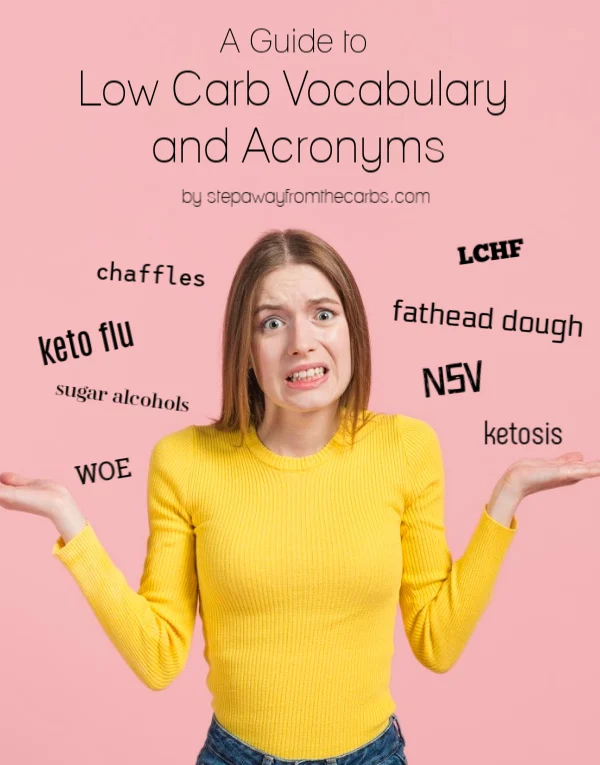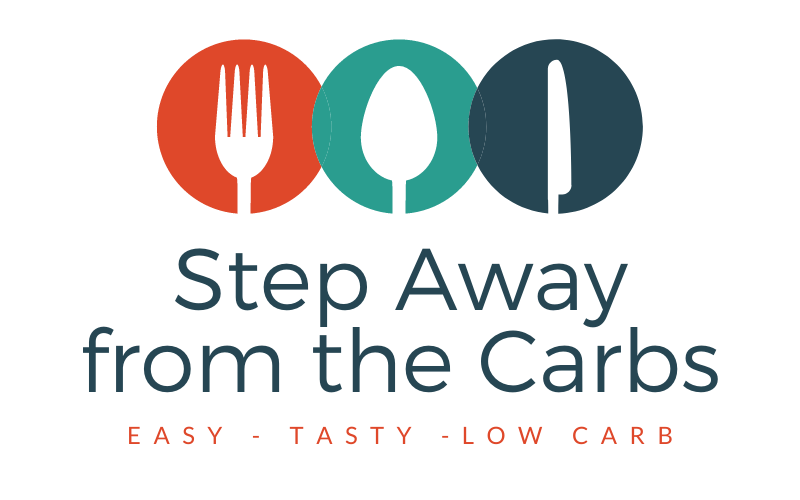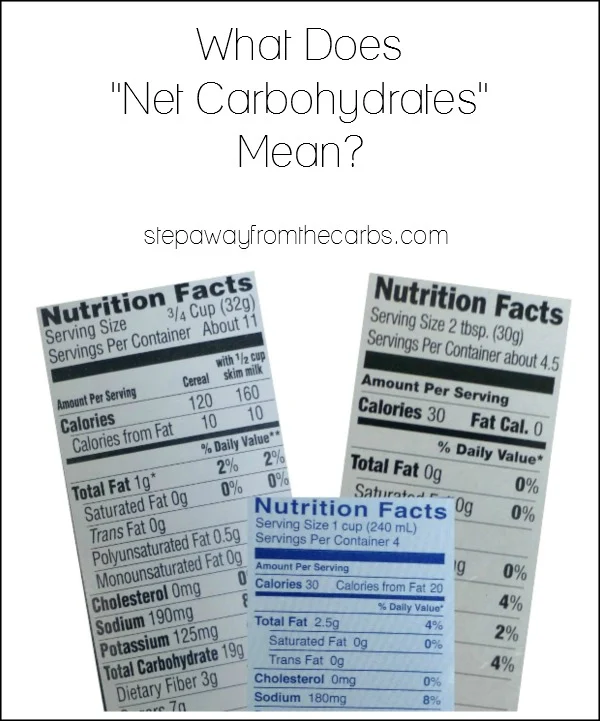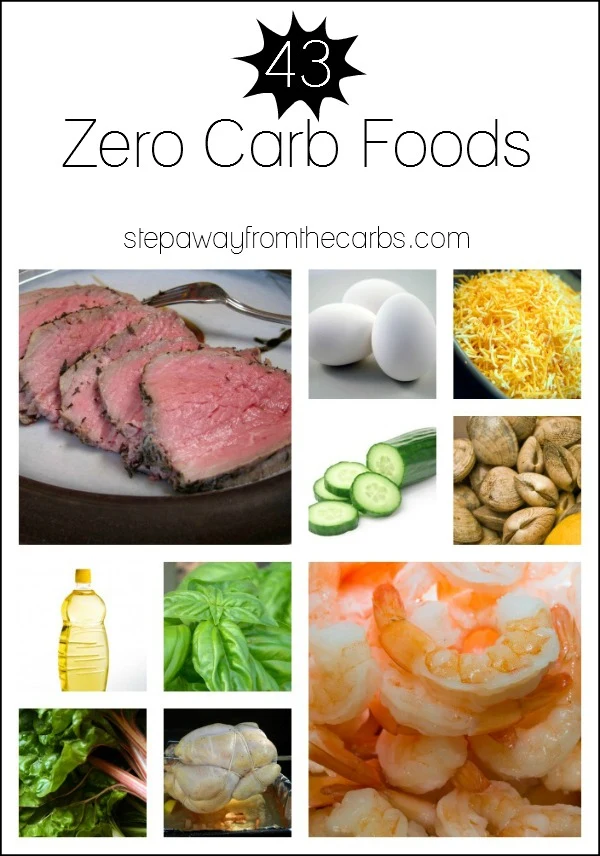Here's a complete guide to all the low carb vocabulary and acronyms that you might come across when following this diet! Ideal for anyone just starting out.

This post may contain affiliate links.
Are you lost in the world of low carb vocabulary? Do you want to be part of the “in” crowd that know what LCHF and WOE mean? Then this resource is for you!
And you might also like to check out my guide to starting a low carb diet – which has a TON of useful information!
Low Carb Vocabulary and Acronyms
Atkins – This refers to a high-protein, high-fat, low carbohydrate diet popularized by Dr. Robert C. Atkins. It has several phases but generally allows for unrestricted amounts of meat, cheese and eggs, while severely restricting carbohydrates, including sugar, bread, pasta, milk, fruits and many vegetables.
BMI – This stands for Body Mass Index: a standard scale that physicians use to compare the ratio between height and weight.
Bulletproof Coffee (or BPC) – A drink made from MCT oils, butter, and coffee that is particularly popular with those following a keto diet (see below) because of the increased fat content. You can make your own or buy it in convenient cartons from online stores like Netrition!
Chaffles – A new trend! It's a waffle, but made with cheese! You can find bunch of chaffle recipes over on my friend's site Two Sleevers!
Collagen – Collagen makes up 30% of the protein in your body, and is found in your bones, skin, muscles, and tendons. There are at least 16 different types of collagen, and it helps with energy production, detoxification, rebuilding damaged joints and even digestion. It's sometimes referred to as the “glue” that holds our bodies together! It works well as a supplement for anyone following a low carb diet, because as well as all the health benefits, it can help you feel fuller for longer! Check out my Introduction to Collagen for Low Carbers.
Dirty Keto – This is a version of the keto diet that involves eating whatever food you like, as long as it fits your macros (see below!).
Egg Fast – You can probably guess what this means! Although not technically a low carb diet, it's something that many low carbers try where they just eat eggs! I have yet to give it a go!
Essential fatty acids – These are the fats that the body actually needs to be healthy.
Fathead Dough – One of my favorite recipes! It's a low carb high fat dough made from cheese, egg, and almond flour. Read more about it in my Ultimate Guide to Fathead Dough (now with video tutorial!)

Fat Bomb – This is a bite-sized snack that is particularly useful for those following a low-carb-high-fat diet. It often contains a combination of heavy cream, butter, coconut oil and/or cream cheese, and can be sweet or savory.
Gluten-free – Not all gluten-free food is low carb, but nearly all low carb is gluten free. Don’t assume that if a product is labeled “gluten free” then it will be low carb, it just means that the food does not contain gluten, which includes wheat, barley, rye, and oat. Note: Most of the recipes on my blog are gluten free, with the exception of those that use low carb tortillas.
Glycemic Index – The measurement of how fast a specific carbohydrate causes a person’s blood sugar level to rise. High glycemic foods can cause blood sugar spikes, which causes the body to produce more insulin.
Keto – This refers to the ketogenic diet, and getting your body into ketosis. Simply put, the body’s first choice of fuel is glucose. If the carbohydrate intake is reduced, there is insufficient glucose to meet the body’s need for energy. So the body burns fat instead – and when this happens you are in the state of ketosis. (By the way I highly recommend Keyto – it's a breath sensor that calculates whether you are in ketosis – SUPER convenient!)

Keto Flu – This usually happens in the first weeks of starting a low carb diet, but doesn’t last much longer. Symptoms differ for each person, but may include headaches, fatigue, cramps, or insomnia.
LCHF – This is an acronym for Low Carb High Fat. Most low-carbers need a reasonable amount of fat to stay in ketosis.
Macros – This is the diet ratio between carbohydrates, fat, and protein. These are often expressed as percentages – a standard for ketogenic dieters is 75% Fat, 5% Carbs & 20% protein.
MCT Oil – MCT stands for medium-chain triglycerides, which are the key fat molecules found in coconut oil. MCTs can be converted into ketones, which are produced from the breakdown of fat when carb intake is low. If you're following a keto diet, then taking MCT oil can help you stay in the fat-burning state known as ketosis, as mentioned above.
Net carbs (or nutritive carbs) – Subtract the amount of dietary fiber from the total carbohydrate count will give you the net carbs. Note: In countries like UK and Australia, the fiber is NOT included in the total carb count. I covered this in one of the very first blog posts on this site!
NSV (Non-Scale Victory) – This refers to not only judging your success by your weight loss. When you start a low carb diet, take measurements across your whole body, and re-measure every month. You may well feel more alert, your clothes might fit better, or you may be able to accomplish tasks that you couldn’t handle before.
Nutrition Data – This is the accepted USDA value given to all foods, with a breakdown of calories, fats, carbs, protein, and more. All commercially manufactured products will carry a Nutrition Label. For other foods, such as meat, fish, and vegetables, check the USDA website.
Paleo – This refers to a way of eating that only includes foods presumed to have been available in the Paleolithic era. There are variations, like most low carb diets, but it typically includes vegetables, fruits, nuts, roots, and meat, but excludes foods such as dairy, grains, sugar, legumes, alcohol and coffee.
Shark Week – This one is for the ladies, and refers to their time of the month, when they often see changes in weight loss and behavior. But guys need to know this too, so that they don’t ask the question. 🙂
Stalling – A common experience for many low carbers that means that they cannot lose weight even if they have been strict with their diet. This can happen for a variety of reasons, and is often caused by the introduction of a new food that has caused the stall.
Starches – This includes foods such as white potatoes, wheat, corn, and sugar. The body has no nutritional need for starches.
Sugar alcohols – To name just a few: maltitol, sorbitol, mannitol, lactitol, xylitol and erythritol. Whether you include them in your carb count depends on the individual. They can cause you to stall and/or elevate blood sugar levels. Some are known to cause laxative effects, so the recommendation is to stay to low levels until you know how they work with your body.
Sweeteners – A subject that is highly controversial! There are artificial sweeteners, natural sweeteners, sugar alcohols (see above), liquid sweeteners, and sweeteners that are not low carb. My best advice is to read the label, only choose what you feel comfortable eating, and go slowly until you know whether the sweetener works for you. For the record my go-to sweetener is Lakanto, and you can get 20% off everything in the Lakanto store when you use coupon code SAFTC!
Sugar Free – Like gluten-free, you cannot assume that this recipe or product that says it is “Sugar Free” will also be low carb. But it may well be LOWER in carbs than a version that contains sugar. Always read the label.
USDA – United States Department of Agriculture. The federal department responsible for laws relating to food, farming, and agriculture.
WOE – Way of Eating. Many people who convert to a low carb diet don’t want to refer to it as a diet – but a lifestyle change instead.
Zero carb – According to the USDA, this term applies to any food that contains less than 1g net carb per serving. But this is where you need to be careful – if a product *actually* contains 0.9g net carbs per serving of one teaspoon, and you need one tablespoon for your recipe, the hidden carbs will start to add up. Always read “zero carb” to mean “really very low carb”, and you’ll be nearer to reality!
Are there any other keto or low carb vocabulary that I missed? Let me know in the comments!
“Confused girl” photo created by freepik – www.freepik.com



